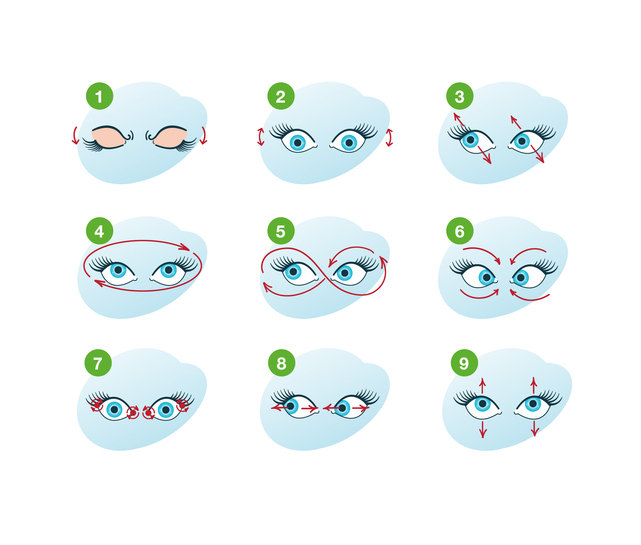When you think about exercise, you often think about the limbs, abs, and shoulders. People often think about the most obvious muscle groups. Most people don’t relate “exercise” to the eyes. It seems almost silly to think about, doesn’t it? The eyes don’t need exercise—they simply do their thing, all the time, without issues!
Of course, many of us who wear glasses know that that’s not true. The eyes do not simply always function perfectly without proper exercise. And your eyes are controlled by muscles; that means that they can very much be exercised like any other muscle in the body. It’s just a matter of knowing how. And we at Microprism vision are happy to offer some helpful tips on vision therapy.
Below are some of the most effective exercises for keeping your vision healthy and reliable.
Vision Training Tricks to Reduce Eye Strain
Eyestrain occurs after intense use of your eyes, usually while focusing on a single thing for a very long period of time. Nowadays. Eyestrain is more common than ever thanks to all the devices we have with screens, which occupy our visual attention for massive swaths of time. Eyestrain mainly causes you fatigue, but it can also lead to difficulty sleeping, dizziness, headaches, and stress.
To avoid eyestrain, you perform the figure-8 exercise. To do so, simply sit in a comfortable spot and focus on a point a moderate distance away. Once you have a point in focus, trace a figure-8 around the point for around a minute, switching directions halfway through. You perform a slight variant exercise by first focusing on a point and then slowly looking above and to each side of the point in turn. This gets your eyes gradually used to the hard work.
Keep Your Focusing Sharp
For many people, focusing their eyesight can be very difficult or largely ineffective due to vision problems. These vision problems are compounded with patients who never trained their eyes to focus.
To work on your focusing, simply find a comfortable position to be in for a little while. Once you have one, simply hold your finger in front of your face, focus your eyes on it, and then focus past them. You can repeat this several times, each time holding your finger at a different distance from your face. That allows you to focus on objects farther away, which includes reading signs and writing from farther away.
Exercises to Train Your Vision for Coordination
Improving your eye coordination is one of the healthiest things you can do for your eyesight. You might be wondering why it’s crucial to coordinate your eyes; after all, you can close one eye and easily see with just the other one. Each eye essentially operates independently, right? Each one can, but coordinating your eyes while both are open can help you avoid a host of different vision issues. Many conditions involve a misalignment of the eyes, which essentially forces your brain to interpret two separate images at all times.
To avoid that mess, take a long string. Attach one end to a stable point in the room; hold the other end right under your nose. Place a bead on the string somewhere near your face. Now, try to focus on the bead in such a way that you see one bead but two strings.
Blinking
The fourth exercise for training your vision is blinking. Now, this might seem like a waste of time – after all, you naturally blink anyway. However, blinking is an important way to keep the eyes fresh and the tear film intact.
Consciously practising blinking may also be an important exercise for those who work office jobs and/or spend a lot of time using electronics. The blue lights emitted by screens unconsciously slow blinking. This is why your eyes might feel dry, fatigued and gritty after prolonged exposure to electronics.
However, the act of blinking activates the oil glands, maintaining the moist tear film over the eye. Therefore, a useful exercise for maintaining your eye health might be to close your eyes – squeezing them shut – and keeping them closed for the count of 2.
In summary, the four practical exercises to train your vision are:
- The figure-8 exercise, as a way of exercising the muscles around your eyes.
- Moving your finger in front of your face, to exercise your focus and perspective.
- Focusing on a bead on a string, to exercise your eyes’ coordination.
- Blinking to lubricate the eye and counteract the effects of blue light.
Though vision training might seem repetitive, it will pay dividends in the long term.
Would you like to speak to one of us about enhancing your vision with Microprism lenses and prism glasses? Just give us a call or book an appointment!
FAQs
How often should I do these exercises?
This depends on your circumstances – for example, an optometrist might recommend you practice these exercises every day. Alternatively, plenty of people practice them whenever they have a spare minute. To achieve the benefits of these exercises, consistency and regularity are important.
If you experience any discomfort while completing these vision exercises, stop immediately and consult an optometrist.
When will I start seeing the results of these exercises?
The observable results will vastly vary from individual to individual: some people, for example, begin seeing minor positive results within a few weeks or months of performing these vision training exercises. However, seeing more significant changes, such as to pre-existing eye conditions, may take longer. However, sticking to an exercise regimen will ensure that you stay on track.
Can visual training exercises improve hand-eye coordination and depth perception?
Any exercise that involves judging distance (such as the finger exercise) will help promote accurate depth perception. These exercises strengthen the brain’s ability to process binocular – or two-eyed – visual cues and subsequently interpret spatial relationships.
Hand-eye coordination can be promoted by exercises that involve tracking objects with your eyes, such as the figure of 8 exercise. For children developing motor coordination, exercises such as these can be extremely helpful.
It’s important to note that the effectiveness of vision exercises will vary depending on individual factors and the regularity of eye vision training.
To find out more and receive personalised tips about how to engage your vision, get in contact with Microprism Vision for your free consultation.


